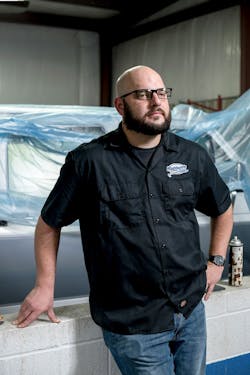Mashburn Collision Center
Location: Lawrenceburg, Tenn.
Size: 12,000 square feet
Staff: 12
Average Monthly Car Count: 55
Annual Revenue: $1.5 Million
Growing up, Cam Mashburn never envisioned a career in the collision repair industry, despite the fact his dad had operated a shop since 1981.
“I knew I didn’t want to push dents and pull dents my whole life,” says Mashburn, a Tennessean with a slight southern drawl. “It just didn’t interest me.”
Instead, Mashburn attended Tennessee Tech, focusing on electrical engineering. The result was a sales engineer job with Verizon Wireless. While that role paid well enough, the hours were long.
“There were times I didn’t leave the office ’til midnight,” he notes. “I hated it. I hated every minute of it,” Mashburn says.
As fortune would have it, in 2007 his father presented an offer to work at Mashburn Collision Center, in Lawrenceburg, Tenn., hoping to reinvigorate a business that had stagnated. This time, family ties won him over.
And, in his new job, Mashburn soon set out to make his work days go much smoother, and in a more efficient fashion, than those long, drawn-out shifts spent working for a cellphone carrier.
The Backstory
The main reason Cam Mashburn was summoned to his family’s body shop: His father, Mike, was confident there was growth potential for the business. The Mashburn family patriarch just wasn’t quite sure how to inspire such growth.
And so, Cam—the businessman—was called in from the bullpen to be manager/owner.
The Mashburns now had their plan; Cam, however, wasn’t initially sure how to put it into motion.
“When I first came here,” Mashburn admits, “I had no idea about body-shop business.”
Mashburn decided to take a studious approach as he threw himself into his new role with the family business, visiting shops around Tennessee and even reading up on technological innovations at shops in Australia.
Mashburn eventually pored over the numbers enough to pinpoint his shop’s main issue: sluggish cycle time.
Expert Advice
Creating a positive team structure in your collision center
It’s not always easy to forge an effective team structure in a body shop. Jim Byron, the longtime owner at Patterson (NY) Auto Body, explains what has worked for him since the early 1980s.
You’ve got to maintain proper structure. In large MSOs, that structure is just automatically there, because it’s cold and it’s chiseled in stone. But in small businesses, you as the small business owner need to instill that every day.
Employees will appreciate that and gravitate to that. So, one day you look at your 35-year business and you go, “Wow, this office manager has been with me 30 years, this body man has been with me 30 years.” You know, we have this feeling of, this is my chosen career path, this is what I elect to do for my livelihood, because I feel fulfilled doing it.
Money, that’s not the number one drive in society. It’s being “part of.” And my guys are “part of.” If we’re discussing the next measuring system, the next welder, the next certification course ... these are all engaged conversations with guys on the floor, guys that are working it every day. You’ve got to be a part of it.
Everything has to be in sync. You have to believe in the mission statement, that they want to be the best, the brightest, the sharpest. If you can believe the mission statement and then look at the structure and where they want you to be in that structure, it’s going to keep you engaged.
Late last decade, MCC’s cycle time languished at 6.5 days per repair. While Mashburn may have been a newcomer to the collision repair industry, he knew it was imperative to improve that key performance indicator.
“When I first came into the business,” Mashburn says, “we were a small shop. So my biggest thing was to start building business and start getting it growing. So, we grew so fast (by 2009) that we had a month backlog.
“We were having a logjam of about a month at times. So I was thinking, ‘OK, we’ve got to get cars in and out quicker.’ That was my motivation.”
Slowly but surely, the young owner was learning that faster repairs make for content customers, and also please insurance companies. But fixing that issue at MCC could only come to fruition after a comprehensive procedural overhaul.
“Anytime you have to re-order, you're losing a day, sometimes two.”
- Cam Mashburn, owner, Mashburn's Collision Center
The Solution
In an effort to get MCC’s cycle time rolling in the right direction, Mashburn set forth on implementing what was essentially a three-pronged plan.
Some of the procedures Mashburn began preaching to employees were simply a reintroduction to SOPs his father had used long ago, that had fallen by the wayside. Others were gleaned after studying more modern options for achieving efficiency in a shop.
Regardless of how they were discovered, the elements of Mashburn’s three-pronged plan combined to pay dividends.
1. Have parts on site before cars arrive. The first element Mashburn used to revitalize his family’s shop was a process his father had long ago instituted, which had become neglected over time.
“Having the parts to do the job before the job gets here was one of the bigger things we did,” the younger Mashburn notes. “We were always ordering parts ahead of time.
“We always made sure we had the parts, and had more than enough,” he adds. “Because anytime you have to re-order, you’re losing a day, sometimes two.”
Mashburn said his father began having parts on site before vehicles arrived back in the early ‘90s, necessitated by his bare-bones staff. It’s a shop process that has as much merit today as it did a quarter century ago.
The trickiest element to MCC’s overhaul has been having ample parts on hand to facilitate fast cycle times without having a costly overabundance.
“You can really get a full parts room really quick,” Mashburn explains. “But it’s a problem I’m willing to take, in order to get cars out quicker. So, when a tech gets a car in, tears it down, he does a parts list. He says ‘OK, here’s what I don’t need that we have. We immediately send those parts back. A lot of it is giving your techs enough information—we print them off probably three or four different sheets, and they know everything about the job.”
2. Use a rolling schedule. Mashburn began making sure MCC’s staff only brought vehicles onto the shop floor that were likely to be touched that day.
“We started with the rolling schedule because I kept noticing cars coming in on Monday and just sitting,” Mashburn recalls. “My techs’ biggest fear with the rolling schedule was having cars hang over the weekend―it’s a cycle time killer. It was a learning process to keep cars from hanging over; it was about learning which types of jobs could be brought in on Wednesday and which ones needed to be brought in on Monday.”
3. Write meticulous estimates. Mashburn―a man who prides himself on being efficient―has never been a fan of dealing with insurance supplements. Before long, that weariness served as proof of the value of thorough, supremely accurate estimates.
“I was absolutely sick of supplements. I [would] rather be working at growing our business instead of working on supplements,” Mashburn says. “If we can get the estimate correct on the front end, especially on non-DRP claims, I can put my focus on the business side.
“We get an accurate estimate written and, if possible, we get the supplement taken care of before the vehicle even makes it into production,” he adds. “Nothing kills cycle time like waiting on an independent adjuster to write the supplement and submit it for approval―you lose two days just waiting.”
Mashburn’s three-pronged approach provided just the jolt MCC needed. Case in point: within one year of implementing a rolling schedule, the shop’s cycle time was reduced from 5.4 days per repair to 4.9.
By the fall of 2016, MCC had whittled its cycle time down to 4.2 days.
“We’re growing at such a fast rate―we have changed so much,” says Mashburn, whose shop has gone from roughly $700,000 in annual revenue 10 years ago to $1.5 million in its current setup.
The manager/owner says his employees have largely embraced new shop processes. And, if a process requires clarification, Mashburn encourages an open line of communication throughout the shop.
“We have an open-door policy,” Mashburn says. “We’re very blunt, we’re very honest. … It makes the shop better—debate is good.”
The Takeaway
Mashburn had to make multiple changes at MCC, which is rarely easy. But he stayed true to his convictions.
Mashburn has learned that body shops, like most businesses, need to constantly evolve, and that a shop owner should always evaluate processes, seeking improvement.
“As the business grows, the culture has to change,” he explains. “Because what worked last year at this time might not be working anymore.”

